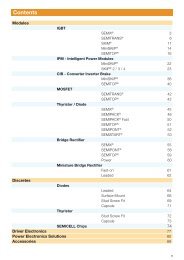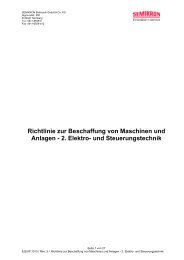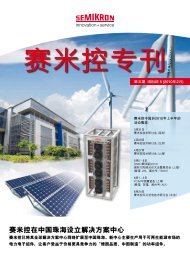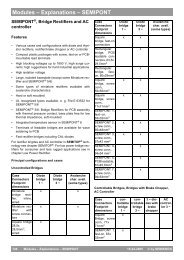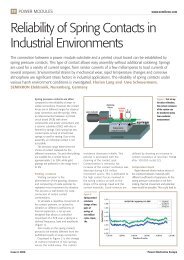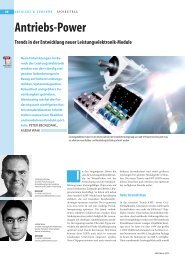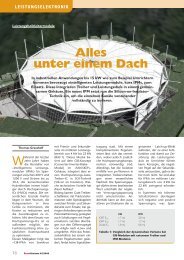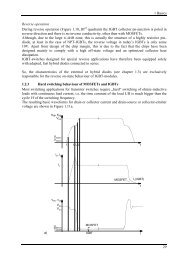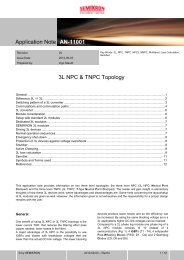High Currents Under Control Compact Vehicle Power ... - Semikron
High Currents Under Control Compact Vehicle Power ... - Semikron
High Currents Under Control Compact Vehicle Power ... - Semikron
Create successful ePaper yourself
Turn your PDF publications into a flip-book with our unique Google optimized e-Paper software.
ISSN: 1863-5598<br />
ZKZ 64717<br />
09-10<br />
Electronics in Motion and Conversion September 2010
COVER STORY<br />
<strong>High</strong> <strong>Currents</strong> <strong>Under</strong> <strong>Control</strong><br />
<strong>Compact</strong> <strong>Vehicle</strong> <strong>Power</strong> Systems<br />
Users of power control equipment have used third-party systems for many years, because<br />
they offer the benefits of reduced development costs, shorter time to market and ease of<br />
meeting qualification standards. As specifications have become more demanding, it has<br />
become necessary to use higher levels of integration, with much tighter control of all the<br />
elements in the system.<br />
By Paul Newman, Managing Director, <strong>Semikron</strong> UK Ltd<br />
To meet the requirements for the broad automotive electronics market<br />
– ranging from fork-lift trucks, to hybrid and electric vehicles, to<br />
large agricultural and construction vehicles – <strong>Semikron</strong> has established<br />
its Systems Group, to bring all the necessary expertise into<br />
one organisation. The Group works closely with customers to develop<br />
power systems, which are then marketed under the SKAI brand.<br />
The second generation of fully integrated and tested SKAI systems<br />
are now available.<br />
The Systems Group has been formed to build on <strong>Semikron</strong>’s many<br />
years of experience in these markets. The company has offered integrated<br />
power electronics to its customers for almost 20 years. Initially<br />
just combining power silicon and drivers in custom-designed enclosures,<br />
these have evolved to become more highly integrated, now<br />
including control electronics designed to be ready to accept software<br />
to produce a complete system.<br />
The SKAI vehicle power systems boast a high level of integration and<br />
offer major advantages over comparable competitor systems. They<br />
are developed in line with the latest automotive standards and system<br />
qualification standards, allowing short time-to-market and lower<br />
development costs. The SKAI systems are supplied as standard platforms<br />
with low-voltage MOSFETS or high-voltage IGBTs as the silicon<br />
base. SKAI systems can also be developed to meet individual<br />
customer specifications. <strong>Semikron</strong> is a single-source supplier,<br />
encompassing everything from feasibility and proof-of-principle studies,<br />
to the development of optimum system architecture, to electrical<br />
and mechanical simulations, end qualification and complete-system<br />
series production.<br />
Aux. power<br />
CAN comm., external I/O<br />
Enclosure IP67<br />
One system, three types<br />
The high-voltage SKAI 2 is available as a water-cooled 600/1200V<br />
IGBT inverter system, and has been optimised for use in applications<br />
such as full-electric cars, plug-in hybrid cars and electric buses. This<br />
system is based on the established sintered, 100% solder-free<br />
SKiM93 IGBT modules, features a polypropylene film DC-link capacitor,<br />
driver electronics, a latest-generation DSP controller, EMC filters,<br />
and current, voltage and temperature sensors, and is supplied in an<br />
IP67 module case. Communication with the vehicle master controller<br />
is via a CAN bus. These systems are designed for outputs of up to<br />
150kW (Figures 1 and 2).<br />
Figure 2: The high-voltage SKAI system is available as a liquidcooled<br />
600/1200V IGBT inverter system, and has been optimised for<br />
use in applications such as full-electric cars, plug-in hybrid cars and<br />
electric buses.<br />
DSP controller<br />
<strong>Power</strong> supply<br />
Gate driver<br />
Protection<br />
<strong>Power</strong><br />
input<br />
terminals<br />
DC-link<br />
capacitor<br />
V<br />
<strong>Power</strong> section<br />
• 3-phase IGBT inverter single/dual<br />
• 3-phase MOSFET inverter single/dual<br />
T<br />
I<br />
I<br />
• DC-DC converter<br />
I<br />
• Battery charger<br />
• Sensors I/T<br />
• EMI filter<br />
Current<br />
Voltage<br />
Temperature<br />
<strong>Power</strong><br />
output<br />
terminals<br />
Heat sink<br />
(Water inlet)<br />
(Water outlet)<br />
Figure 1: A typical SKAI system architecture<br />
Figure 3: The low-voltage version is available as an air-cooled or liquid-cooled<br />
50/100/150/200V MOSFETsingle and dual inverter system,<br />
which is used in material handling and smaller vehicles.<br />
20 Bodo´s <strong>Power</strong> Systems ® September 2010 www.bodospower.com
COVER STORY<br />
The low-voltage version is available as an air-cooled or liquid-cooled<br />
50/100/150/200V MOSFET single and dual inverter system, which is<br />
used for material handling and smaller vehicles. These systems are<br />
suitable for a motor output power of up to 40kW. They incorporate<br />
many of the same features as the IGBT-based systems and therefore<br />
offer the benefits to customers that they behave in the same way,<br />
use the same core control system and I/O connections, and the<br />
same system structure (Figure 3).<br />
The third type of SKAI 2 platform is a multi-converter box. These systems<br />
are also housed in liquid-cooled, IP67-protected cases and<br />
communicate with the vehicle master controller via a CAN bus. The<br />
signal interface features analogue and digital I/Os to allow for the<br />
connection of a wide variety of sensors, such as temperature sensors<br />
and resolver inputs. A typical multi-converter system would include a<br />
three-phase 40kVA active front-end converter, a three-phase 20kVA<br />
drive inverter, a three-phase 10kVA drive inverter, and a 14V/300A or<br />
28V/165A DC/DC converter (Figures 4 and 5).<br />
AD<br />
Figure 4: Topology of a typical multi-converter system<br />
Figure 5: The SKAI 2 highly integrated multi-converter system<br />
All SKAI 2 modules are fully qualified using test techniques such as<br />
highly-accelerated life testing (HALT) and end of component-life testing,<br />
with full failure-mode effect analysis studies conducted at all critical<br />
points of the design cycle, to ensure that they are in line with relevant<br />
automotive standards. Thermal and electrical contact of the<br />
power semiconductors is established by pressure contact technology,<br />
which boasts extended service life and high load cycling capability.<br />
The systems and semiconductor components are manufactured in<br />
high-tech production processes that include end-of-line function tests<br />
and, if required, 100% burn-in tests, ensuring a high degree of quality.<br />
Novel technologies<br />
There are many factors that affect the efficiency and reliability of<br />
power systems.<br />
www.bodospower.com September 2010 Bodo´s <strong>Power</strong> Systems ®<br />
21
COVER STORY<br />
To achieve maximum energy, cost and space efficiency, coupled with<br />
high reliability, it is important to combine the best silicon, packaging,<br />
layout, thermal performance and control in the design and manufacture<br />
of power systems. This can often be difficult if the designer has<br />
to depend on off-the-shelf parts. It is very important to be able to optimise<br />
the selection of silicon and to be able to connect it as needed<br />
for optimum performance in a system.<br />
Many suppliers of systems focus on a single technology, such as<br />
MOSFET or IGBT, or may concentrate on applications at a single<br />
voltage. However, the wide variation in requirements of today’s systems<br />
makes it important to be able to choose from the widest selection<br />
of semiconductor technology to achieve the best match to the<br />
application. It is also important for the design process to take into<br />
account the many issues dependent on the semiconductor technology<br />
and the relationships between them, to ensure that the hardware<br />
is optimised for the application. As <strong>Semikron</strong> is a major manufacturer<br />
of power semiconductors, it can push boundaries in areas such as<br />
temperature and size. For example, the company produces very<br />
large volumes of IGBT and MOSFET drivers, and from this expertise<br />
has developed optimised application specific integrated circuits<br />
(ASICs) to significantly reduce component count and increase reliability,<br />
while reducing size dramatically.<br />
Current developments in power electronics aim to achieve higher current<br />
densities, system integration and greater reliability. At the same time,<br />
there is more call for low-cost, standardized interfaces, as well as flexible<br />
and modular product series. <strong>Semikron</strong> has set trends in this area by the<br />
use of spring contacts for the auxiliary and load connections.<br />
The reliability of classical module designs is not sufficient for many<br />
developing applications in power electronics. For example, these<br />
modules are limited in their capability to withstand passive temperature<br />
cycles. It has therefore been necessary to develop new techniques,<br />
which are capable of meeting the high-reliability requirements<br />
of modern applications.<br />
A major limitation of power module lifetime is the problem of solder<br />
fatigue. In traditional constructions, this contributes to the end-of-life<br />
failure of power modules, especially in the case of higher temperature<br />
swings, which are predominant in most applications. Several<br />
new technologies have been developed to eliminate all solder interfaces.<br />
Each of these offers advantages compared with traditional<br />
constructions, but in combination they offer significant benefits.<br />
The most significant problem caused by higher temperatures and<br />
larger swings of temperature is delamination of soldered joints. This<br />
problem has been completely overcome in the latest SKAI systems<br />
by using sinter technology to join the semiconductor chips to the<br />
ceramic substrate instead of solder, meaning that higher operating<br />
temperatures are possible with increased reliability. The sinter bond<br />
is a thin silver layer that has a superior thermal resistance to a soldered<br />
joint and contains far fewer, and smaller, voids. It is not subject<br />
to the delamination that affects solder joints, resulting in a low thermal<br />
resistance that remains low over many tens of thousands of<br />
power cycles. The high melting point of silver also prevents premature<br />
material fatigue.<br />
Another issue raised by increased junction temperatures is the<br />
fatigue of the wire bonds used to join the chips to the substrate. This<br />
has been minimised by a number of changes to production techniques,<br />
including changing the geometry of welded joints and the<br />
introduction of novel stress-relief techniques.<br />
SKAI 2 systems are offered with or without control software. If<br />
required, <strong>Semikron</strong> will work with its customers to develop software<br />
or the customer may prefer to use its own. This gives the customer<br />
much more versatility and the capability to produce systems with its<br />
own custom features.<br />
SKAI 2 system in tractor application<br />
The system is also integrated in tractors. An example:<br />
A tractor manufacturer was developing an electric power supply system<br />
for its upper power-class tractors, with the aim of reducing fuel<br />
consumption and noise emissions. The development was also intended<br />
to introduce the architecture needed for additional electric drive<br />
applications in agricultural machinery.<br />
Until now, secondary equipment in tractors has been connected to<br />
the main drive mechanically via gears. This does not enable these<br />
functions to operate at the optimum operating point, leading to poor<br />
overall efficiency and consequently to increased fuel consumption<br />
and pollutant emissions. The aim was therefore to disconnect the<br />
secondary equipment from the main drive. For this purpose, a modified<br />
generator connected to the main drive would be used to generate<br />
electric power. This would then be electrically converted to<br />
ensure optimum operation of the fan, air compressor, air conditioning<br />
equipment and the 14V on-board power-supply.<br />
A highly-integrated power electronics system from the multi-converter<br />
system family was developed to meet the customer’s specifications.<br />
The system comprises multiple converters used to control electric<br />
current flow under harsh ambient conditions. Different operating<br />
modes are possible, for example the system can be supplied with<br />
electric power by way of a three-phase generator or an HVDC bus.<br />
The system communicates with the vehicle master controller via a<br />
CAN bus. The integrated semiconductor components come from the<br />
tried and tested MiniSKiiP family (2nd generation). The signal interface<br />
features analogue and digital I/Os to allow for the connection of<br />
a wide variety of sensors, such as temperature sensors and resolver<br />
inputs.<br />
The new electric power supply system is the basis for the introduction<br />
of ultra-precise, highly efficient electric drives for attachment and<br />
trailer equipment, as well in final drive systems. The combination of<br />
different technological solutions results in far lower fuel consumption<br />
and reduced noise emissions, and ensures that future emissions limits<br />
are met. All of the power transmission components were developed<br />
or optimised in order to improve overall efficiency. In summary,<br />
this constitutes a milestone on the path towards ultra-low consumption<br />
in upper power class tractors, which are normally prone to high<br />
consumption.<br />
Integrated power systems<br />
Many advances in the drive for higher integration of power systems<br />
have been made. However, further advances in reliability, efficiency,<br />
size and versatility will be needed to increase the market acceptance<br />
of integrated power systems. By offering system-wide expertise in<br />
one organisation, <strong>Semikron</strong>’s Systems Group is well placed to develop<br />
higher levels of integration, improved cooling technologies, higher<br />
silicon operating temperatures, higher performance from ASICs and<br />
novel packaging techniques. New insulation systems, new methods<br />
of silicon attach and, in time, the total removal of wire bonds, will all<br />
improve efficiency and reliability still further.<br />
www.semikron.com<br />
22 Bodo´s <strong>Power</strong> Systems ® September 2010 www.bodospower.com



